 The Middle
The Middle
Following are several posts that deal with the Middle (1/2). My hope is that they may stimulate more insight about what works in your Middle and where you might put a bit more attention.
The Middle
Crisis
Crisis
The Middle
Consider the Reader
Viewing: Blog Posts Tagged with: writing the Middle, Most Recent at Top [Help]
Results 1 - 6 of 6
Blog: Plot Whisperer for Writers and Readers (Login to Add to MyJacketFlap)
JacketFlap tags: writing the crisis, Martha Alderson, plot whisperer, Blockbuster Plots for Writers, International Plot Writing Month rewriting tips, writing the Middle, Add a tag
Blog: Plot Whisperer for Writers and Readers (Login to Add to MyJacketFlap)
JacketFlap tags: writing the Middle, writing plot, plot whisperer, International Plot Writing Month, National Plot Writing Month rewriting tips, Add a tag
Now it's time for the Middle (1/2) of your Plot Planner.
I want you to create the Middle portion of your Plot Planner similar to how you created the other two parts of your Plot Planner. To review, so far, you have an index card or piece of 8 1/2 X 11 piece of paper or whatever works best for you as the Plot Planner of the Beginning and one for the End of your story AND a smaller version for the Middle where you had plotted at least one or possibly two scenes from the Middle section.
Blog: Plot Whisperer for Writers and Readers (Login to Add to MyJacketFlap)
JacketFlap tags: writing the Middle, writing the crisis, Martha Alderson, plot whisperer, Blockbuster Plots for Writers, International Plot Writing Month rewriting tips, Add a tag
Following are several posts that deal with the Middle (1/2). My hope is that they may stimulate more insight about what works in your Middle and where you might put a bit more attention.
The Middle
Crisis
Crisis
The Middle
Consider the Reader
Blog: Plot Whisperer for Writers and Readers (Login to Add to MyJacketFlap)
JacketFlap tags: Crisis, writing the Middle, Plot tips, Add a tag
Two recent plot consultations revealed the same dilemma -- both writers were faltering as they made the approach to the Crisis, which occurs about 3/4, give or take, through the entire project.
The Problem
Characters, setting, set-up, premise, and action move from the superficial, introductory mode of the Beginning to the gritty, challenging world of the Middle, the heart of the story world itself.
In the middle, masks fall away and the characters reveal themselves for who they truly are, warts, flaws, fears, prejudices, and all. At this point in the relationship, just like in life, the story tends to get messy. Fights can ensue. Feelings can get hurt. Because of that, writers often back away, afraid of what the characters will reveal about themselves, doubting their ability to manage the dark side of the characters.
Writers tend to want to back off when they approach the Crisis. And why not? We shy away from disaster, drastic upheaval, or deep loss in our own lives. Why would we want to do any differently for our characters? Yet, that is exactly what the Crisis is -- the suffering that occurs when the protagonist's whole world shatters and doesn't make sense anymore. Because only out of the ashes of the old self can a new self come into being -- the beginning of the character's ultimate transformation.
When things get messy, writers often long for the good old days at the Beginning of the relationship when things were smooth and happy, and superficial. Don’t give into the urge to go back and start over again. The truth of the relationship and the characters emerge in the Middle.
Plot Tips and Tricks
1) Use of Antagonists
Writers who make friends with as many antagonists as they can create seem to slog their way through the Middle without as much mishap as those who have not fostered such relationships.
The six basic antagonists are: other people, nature, God, machines, society and the characters themselves.
If you are trying to deepen your skill at showing character development, of the six antagonists, the inner workings of the characters themselves offer the richest form of support. In terms of plot, three basic character traits have the potential to create scenes with the most conflict, tension and suspense or curiosity: the character’s flaw, fear, and hatred.
For example, in the Beginning of To Kill A Mockingbird, Harper Lee introduces Scout, the protagonist, with the flaw, among others, of being insensitive to other people’s feelings. In the Middle, Lee turns the tables on Scout. Now, rather than continue to see all the ways Scout demonstrates her insensitivity to others, the reader sees how Scout suffers the effects of others’ insensitivity, from her cousin acts of cruelty towards her to how a white townsperson married to a black woman deals with the insensitivity of the community around him.
Scout’s flaw is not the only antagonist that creates more conflict, tension and suspense in very scene. The Middle is fraught with antagonists of every sort. Her father serves as an antagonist when he asks Scout to control her temper and her fists. Because of scenes in the Beginning showing Scout’s impulsive fits of anger, the reader knows as well as Scout and her father just how hard it will be for the eight-year-old to control these two shadow aspects of herself.
Lee employs other antagonists in the Middle: an old mad dog down yonder; Mrs. Dubose, a neighbor who symbolizes the collective consciousness of the town folk or society at large; Aunt Alexandra; grown men of the community; etc.
2) Unusual world
The Plot Planner mimics the universal story form with a line that moves steadily upward to denote the necessity of giving each scene more significance to the character and more conflict, tension and suspense in the dramatic action than the scene that came before it.
A trick that can help you over the roughest territory of all: the middle of the Middle is to create an unusual world. So long as you keep a measure of conflict, tension and suspense alive, the actual dramatic action can flatten out a bit in the middle of the Middle. Here, the writer can take time to deepen the readers’ appreciation of an unusual job, setting, lifestyle, custom, ritual, sport, belief or whatever your imagination dreams up.
This world, whether real or imagined, comes alive with authentic details most relevant to the unusual world, specific details the average reader does not yet know or appreciate.
For example, in the Middle of Memoirs of a Geisha, Arthur Golden shows the world of the geisha as the protagonist herself learns about the expectations, dance steps, joke making, dress and hair.
In the Middle of Where the Wild Things Are, Maurice Sendak shows us through six pages of illustrations the unusual world of wild things making rumpus.
In the Middle of My Half of the Sky, Jana McBurney Lin shows the everyday life of a tea seller in China.
The next time you find yourself bogged down in the Middle, don’t resort to going back and starting again. You will only end up finding yourself in a seemingly never-ending cycle. Instead, make a list of all the antagonists you can think of that are relevant to the overall plot or thematic significance. Add the development of an unusual world, and see if you don’t find yourself jumping from one scene to the next, and bypassing the quicksand of the Middle all together.
Do you have any tips to help writers slog their way through the middle??? Any tips about writing the build-up to and the actual Crisis??? Please do share.......
Read the rest of this post
Blog: Plot Whisperer for Writers and Readers (Login to Add to MyJacketFlap)
JacketFlap tags: antagonists, PLot Planner, writing the Middle, adversity, writing the Beginning, writing the End, Add a tag
Adversity does not build character.
Adversity reveals it.
The Beginning of a memoir or work of fiction (1/4 of the entire project) for any age group serves -- among other things like the setting, the dramatic question, the mystery - if there is one, the love interest- if there is one, and the like -- to introduce the character's emotional development. This is where the character strengths and flaws, loves and hates, dreams and goals are introduced.
The Middle (1/2 of the entire project) serves to reveal the deeper nuances of the character's emotional development. This is the part of the story where the writer thrusts the protagonist into as much adversity as possible in order to reveal to the reader or movie goer who the character really is. (Plot tip: make a list of all possible antagonists-- other people, nature, society, belief system, and/or machines -- that can help to create conflict, tension and suspense or curiosity and thus reveal who the character is under pressure -- the more pressure the better)
The End (1/4 of the project) is that portion of the project that actually shows how the character's emotional development has been affected by the adversity in the Middle and reveals how the character has been transformed.
These steps in the overall character emotional transformation can be plotted out on a Plot Planner for ease in developing your project.
What is the most revealing adversity you have experienced either through your character or in your own life?
Blog: Kate's Book Blog (Login to Add to MyJacketFlap)
JacketFlap tags: california, stars, moon, slot canyon, lunar eclipse, california overland, desert, anzo-borrego, scorpions, dennis mammana, Add a tag
My blog's been quiet for the past week because I was in San Diego on a family vacation. It was an incredible week in so many ways, but this was the highlight...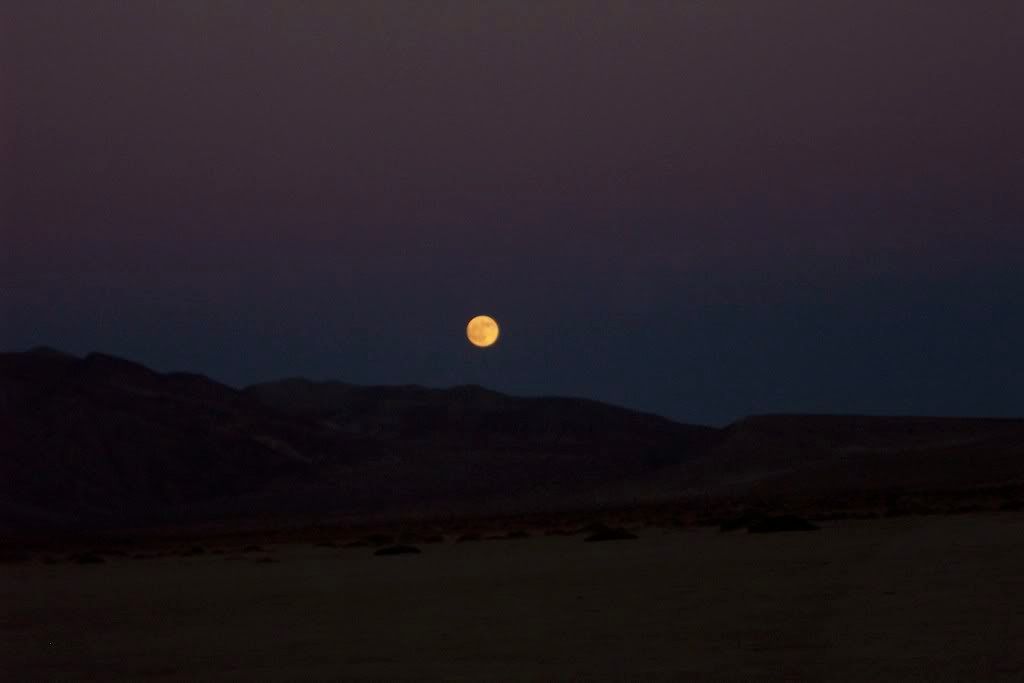
I was lucky enough to spend last Monday, the night of the total lunar eclipse, camping in the middle of Anzo-Borrego Desert State Park. Before we left, we found California Overland online and learned that they were offering an overnight desert trip with astronomer Dennis Mammana on the night of the eclipse. I took this picture just as the moon was rising over the mountains on our way to the campsite.

Joe is every bit as cool as he looks and is one of my family's new favorite people. He organized our trip, cooked our meals, set up our tents, and was an amazing tour guide for the stunning alien landscape he calls home. Our tour started with a drive in a refurbished military vehicle to a spectacular spot called Font's Point, overlooking the Anzo Borrego Badlands. Joe walked us partway up a hill, then said, "Look down at your feet now, and keep walking toward my voice. Don't look up until I tell you to." We trusted Joe by then, so we did this. When he told us to look up, we were at the edge of a cliff looking out at this view.

As the sun went down and the moon came up, we headed to our campsite, near an old homestead that's been swallowed up by sand dunes and tamarack trees. The tents were already set up, and Joe started cooking dinner. Joe, it turns out, is a better cook in the middle of the desert than I am in my own fully-equipped kitchen. Without running water or electricity or anything but an open fire, he whipped up grilled steak, herb-rubbed salmon, roasted corn on the cob, and a beautiful salad with greens and goat cheese. I like food a lot, so Joe was especially my hero then.
 Astronomer Dennis Mammana joined us for dinner and then went off to set up his telescope away from the light of the fire. When the lunar eclipse started in the early hours of the morning, we dozed in a circle of camp chairs around the telescope and took turns snapping pictures through its lens.
Astronomer Dennis Mammana joined us for dinner and then went off to set up his telescope away from the light of the fire. When the lunar eclipse started in the early hours of the morning, we dozed in a circle of camp chairs around the telescope and took turns snapping pictures through its lens.The full moon lit the desert so completely that we didn't need flashlights when it first came up, but as the eclipse began, that light faded into a darkness blacker than any sky I've ever seen.
And then there were stars. Stars like I've never even imagined. Anzo Borrego has been named one of the best star-watching spots in the country, and now I know why. Dennis turned his telescope every few minutes to point out something new. Jupiter with four moons clearly visible. The Andromeda Galaxy. And my favorite... The Orion Nebula, where new stars are born. And of course, all the while, there was the moon...
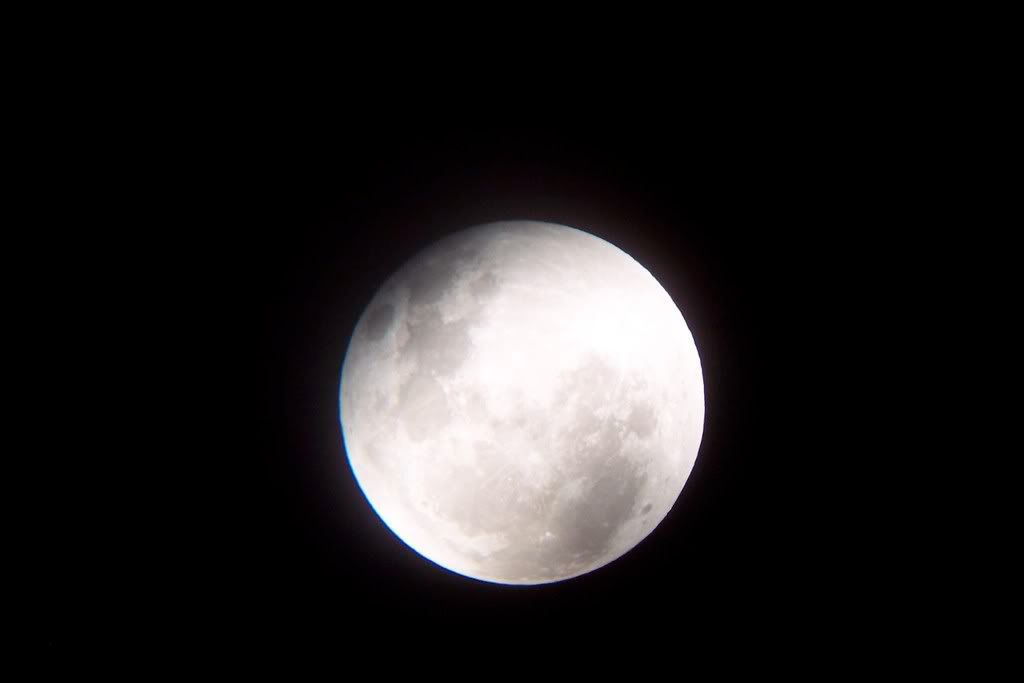


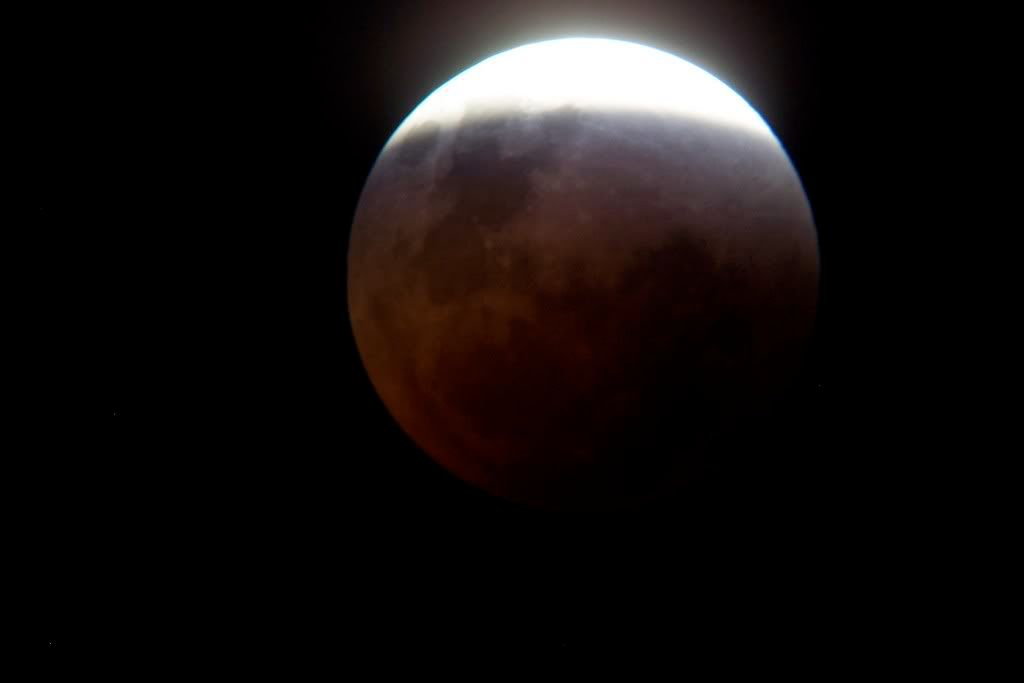


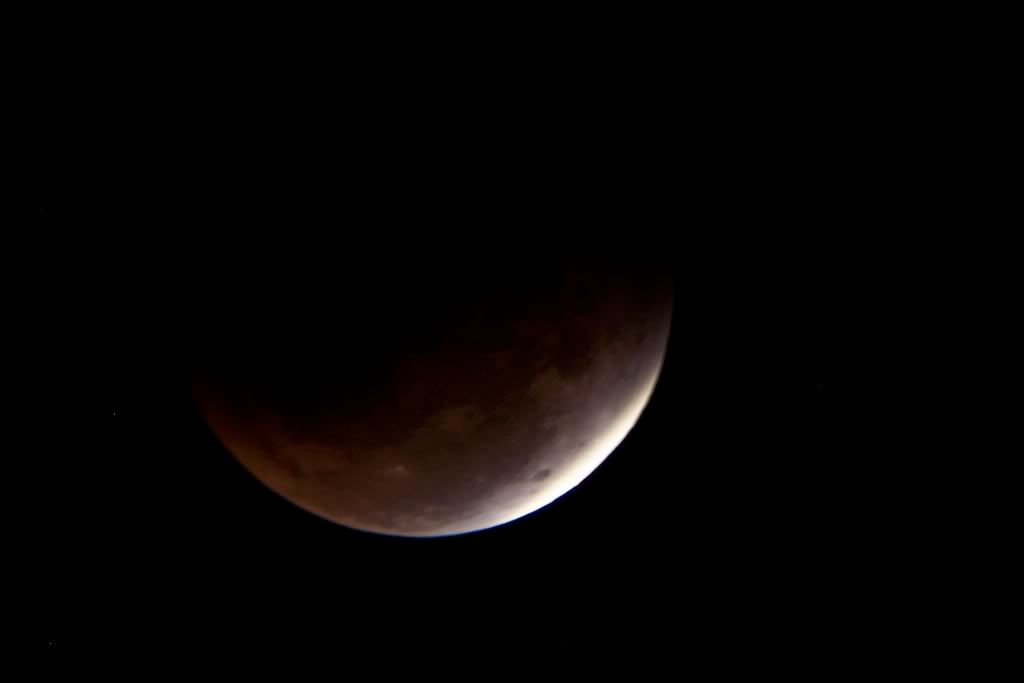

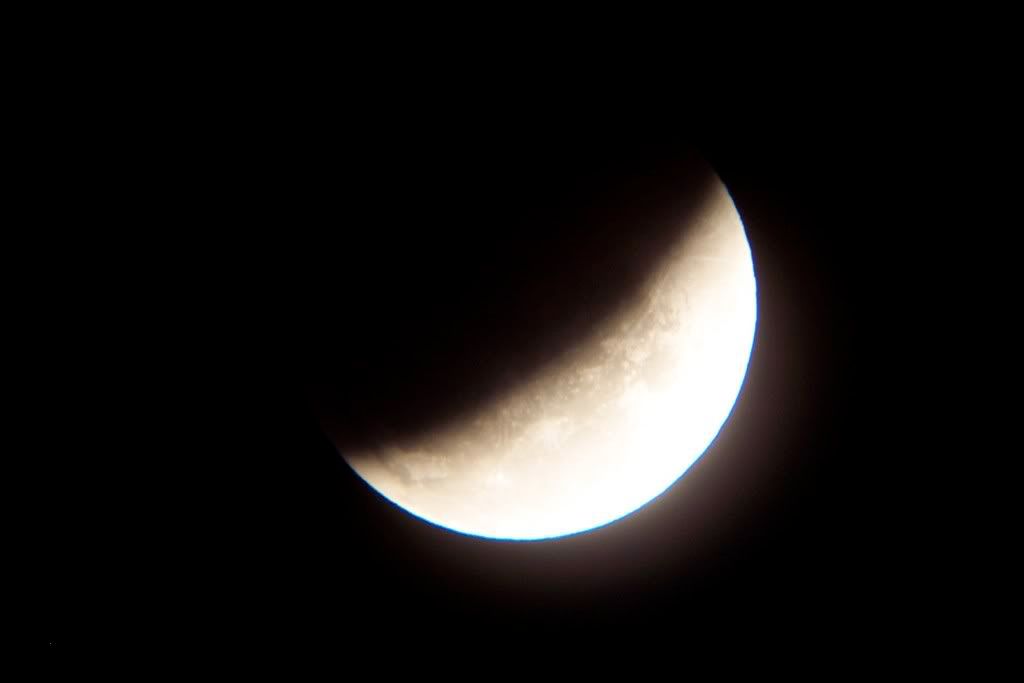
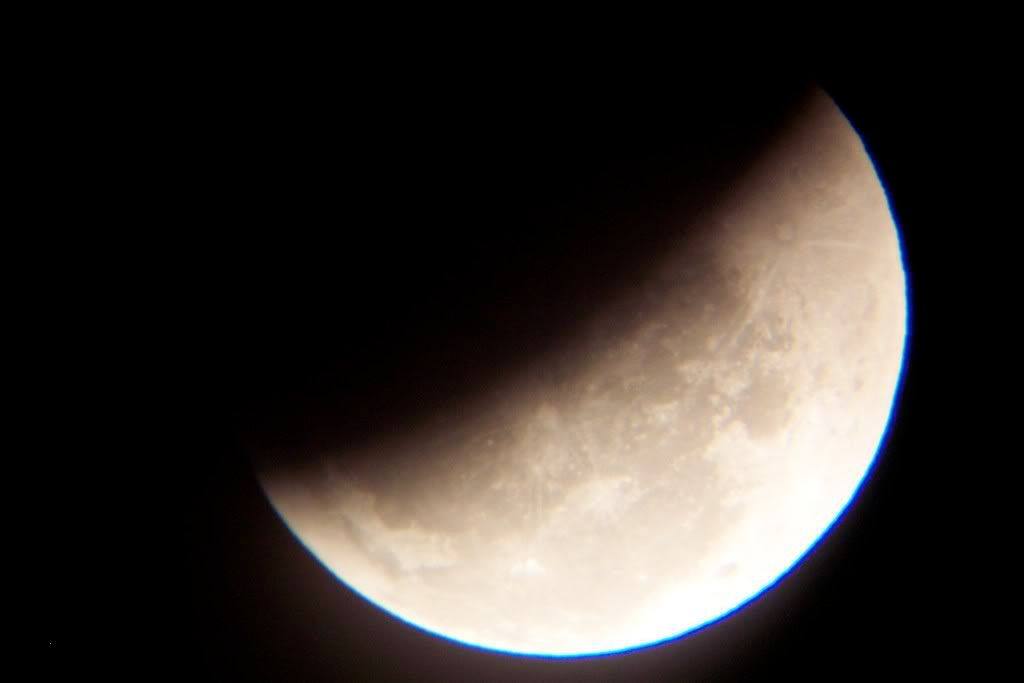

This was my last eclipse photo...taken after a 4am hike through the sand with Joe and my son, looking for scorpions and sidewinders. We didn't find any but enjoyed the quiet and the stars all the same. At about 5:30 the need for a little sleep won out over my desire to see the rest of the moon appear.
When the sun came up, I took a walk away from the campsite a bit to check out the desert plants and see if I could find that elusive scorpion. Here's a shot looking back at our tents.

After a breakfast of toast, turkey bacon, and omelets with fresh vegetables, it was time to take down the tents. And guess who scuttled out from underneath our tent when we started folding it up...

My 11-year-old has wanted to see a scorpion ever since he read about desert animals when he was four or five, so this guy's appearance made his trip complete.

The kids were still itching to do some hiking, so the amazing Joe was kind enough to take us on a bonus trip to one of Anzo Borrego's incredible slot canyons.

The sandstone walls were just a couple feet apart in places, so this was like no other trail I've ever hiked. The temperature had crept up to 113 by the time we made it into the canyon, so we stopped often to find shade and drink water. It gave me a dramatic appreciation for how extreme the desert can be and a true respect for the wildlife and plants that survive in this climate.
As I type this, I'm back home at my desk, getting ready for the start of school in a couple days.
Fall comes early to the Champlain Valley. We woke up to a crisp 42-degrees today, so the desert dust and heat are miles and memories away.
But last night, when I realized I'd forgotten to get the mail, I stepped out into the dark. I looked up at the stars, fighting with our streetlights, and a part of me slipped away, back to my camp chair in Anzo-Borrego, home of the sky and the scorpions, and the stars.



I have found your advice about comparing the beginning and end of the stories and finding connections between them, invaluable. So many new insights have been revealed. My novel is opening up like a flower, slowly revealing itself. Many thanks